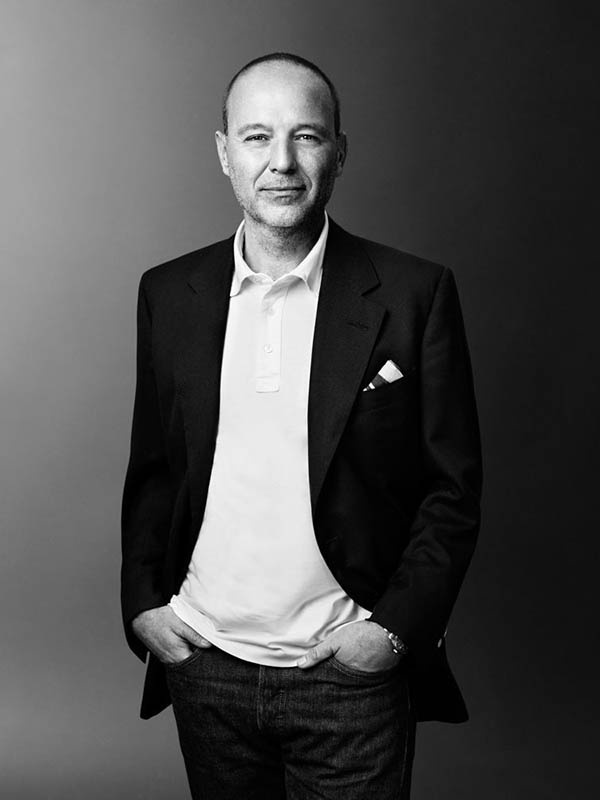
Our founder, David Bonnouvrier, is profiled by journalist, David Colman, for Interview magazine’s September issue. Bonnouvrier opens up about completing his duty in the army to starting his career in fashion, the first time he laid on eyes on Karolina Kurkova, and the distinct qualities he looks for when signing a model to DNA. Read their complete conversation, after the jump.
DAVID COLMAN: What was your entry point into all this?
DAVID BONNOUVRIER: When I came back from the army, I got a job at Elle magazine in France, which, in 1985, was like American Vogue. It was the fashion bible. I loved the magazine side of the business. I was in heaven. After a couple of years, I was going to leave to work for a production company that made TV commercials, and I was really excited because that was ultimately what I wanted to do. They were working with people like Jean-Paul Goude. But my father had started his own agency in 1975, and the day before I was about to sign my contract, he called me and asked if I would come and work with him. I said yes without thinking about it—it took me years of therapy to get to the bottom of that. Several years later, I was offered a job to work at Wilhemina in New York. My girlfriend at the time was at Columbia University, and I was getting tired of flying every other weekend across the Atlantic Ocean. So I took a job and left for New York. I only worked there for six months.
What did you do after that?
My dad and I found an investor to start an agency in Paris and New York. That didn’t work, so at the end of those two years, we parted ways to start DNA.
Who were the big girls you had at that moment?
None. [laughs] We had to start from scratch. But what happened is that we came across this young American girl called Annie Morton. Annie became like the George Washington of DNA. Because we had nothing else to do, she became a mission for us, which translated into getting her on the cover of British Vogue. So that got us on the map for a minute. But when we started DNA, there were a few agencies that were extremely powerful at the time—Elite, Women, Next—so the game for us was just to wait it out. Then in ’96 or ’97, one of the top agents at Elite walked away and the whole agency disintegrated. Trish Goff and Kirsty Hume came to DNA. In 1999, I came across Karolina Kurkova and that changed everything. We brought her back to New York, and within six months of her arrival, she was on the cover of American Vogue. We found her in a small agency in Milan. She had this big banana smile on her face and it was like she had an inscription on her forehead that said, “Please take me away.” [laughs] I think Natalia [Vodianova] was a year or so after that. By then, Women had collapsed and Stella Tennant came to us out of Women. It was incredible. That’s when we got involved with defining what the DNA values were, and where we stood in this business versus our competitors.
What are those values?
We have fewer girls than many of our competitors—on the main board, no more than 65 models. We got that philosophy from working with Annie Morton. When we started, we were five agents for one girl. And we know that we can only do that for a few at a time.
So you’re not starting an athlete’s division?
We know fashion. We’re not TV agents, we’re not CAA, we’re not impresarios. The clients that we have—the Linda Evangelistas, the Natalias, the Kristen McMenamys, the Stellas, Raquel Zimmermanns—they’re real models. There’s a twist, which is that social media aspect that has become a part of their careers. For instance, we represent Doutzen Kroes. Doutzen has had an extraordinary career. She’s probably one of the most beautiful women you’ll ever see. She has a Victoria’s Secret contract and a L’Oreal contract. She has like 500,000 followers on Twitter and 300,000 on Facebook. For her clients, it’s very important that she has that following on social media. She uses it very wisely. Clients do ask about that; they do look at that as a huge plus when they’re going to spend two or three million dollars to put someone on contract. But Linda and Kristen McMenamy don’t tweet, and Stella just barely got an iPad, god bless. But we encourage connectivity.
What qualities do you look for in a model?
One thing we look for is someone who is going to be extremely positive and dedicated and is going to take it extremely seriously. You’re only going to get by so far by being the highest-stakes con artist in the world. Social interactions with this industry are key. You’re at a fitting with Karl Lagerfeld or John Galliano, or you’re on a shoot with people like Fabien [Baron] or Steven [Meisel]—they’re going to want to know that they can relate to you, that you understand their visual language. The people who work in this industry, whether it’s a designer or a photographer, are passionate. They know everything there is about it. They don’t want to surround themselves with tourists … The most important and relevant models are those who understood that.
